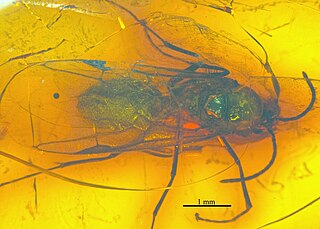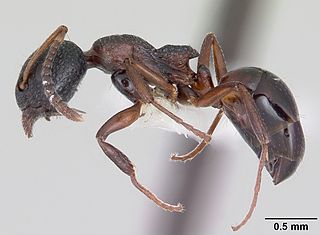
Dolichoderus is a genus of ants found worldwide.

Crematogaster carinata is a species of ant in the tribe Crematogastrini. It was first described by Gustav Mayr in 1862. It is native to Central and South America, where it is a common species, forming large colonies in the canopy of the forest.

Emplastus is an extinct morphogenus of ants in the subfamily Dolichoderinae, known from fossils found in Asia and Europe. The genus contains twelve species described from sites in England, Eastern Europe and Far Eastern Russia.
Dolichoderus angusticornis is a species of ant in the genus Dolichoderus. Described by John S. Clark in 1930, the species is endemic to Australia, found in dry scrub heath in Western Australia and South Australia. Workers are diurnal and foraging during the day and at night.

Dolichoderus balticus is an extinct species of Eocene ant in the genus Dolichoderus. Described by Mayr in 1868, the fossils of a worker, queen and male of the species were discovered in the Baltic Amber.
Dolichoderus clarki is a species of ant in the genus Dolichoderus. Described by William Morton Wheeler in 1935, the species is found in wet sclerophyll areas of the central coast of New South Wales and the Australian Capital Territory. Workers of this species are known to forage on ground and on low vegetation.
Dolichoderus coniger is a species of ant in the genus Dolichoderus. Described by Mayr in 1870, the species is endemic to Borneo.

Dolichoderus cornutus is an extinct species of Eocene ant in the genus Dolichoderus. Described by Mayr in 1868, the fossils were discovered in the Baltic amber, where a fossilised worker ant was only described, and it is presumed these ants existed at least 40 million years ago.
Dolichoderus curvilobus is a species of ant in the genus Dolichoderus. Described by Lattke in 1987, the species is endemic to Colombia and Costa Rica.
Dolichoderus epetreius is a species of ant in the genus Dolichoderus. Described by Lattke in 1987, the species is only known to be endemic to Venezuela.
Dolichoderus ghilianii is a species of ant in the genus Dolichoderus. Described by Emery in 1894, the species is endemic to Brazil, and Peru.
Dolichoderus imitator is a species of ant in the genus Dolichoderus. Described by Emery in 1894, the species is endemic to Bolivia, Brazil and Ecuador.

Dolichoderus kinabaluensis is a species of ant in the genus Dolichoderus. Described by Dill in 2002, the species is endemic to Borneo.

Dolichoderus longipennis is an extinct species of Eocene ant in the genus Dolichoderus. Described by Mayr in 1868, the fossils were discovered in the Baltic Amber.
Dolichoderus patens is a species of ant in the genus Dolichoderus. Described by Mayr in 1870, the species is endemic to Borneo.

Dolichoderus plagiatus is a species of ant in the genus Dolichoderus. It was described by Mayr in 1870.

Dolichoderus sculpturatus is an extinct species of ant in the genus Dolichoderus. Described by Mayr in 1868, a fossilised worker was discovered and described in the Baltic amber.

Dolichoderus sulcaticeps is a species of ant in the genus Dolichoderus. Described by Mayr in 1870, the species is endemic to Borneo, Indonesia, Malaysia, Thailand and Vietnam.

Dolichoderus taschenbergi is a species of ant in the genus Dolichoderus. Described by Mayr in 1866, the species is endemic to Canada and the United States.
Dolichoderus tricolor is a species of ant in the genus Dolichoderus. Described by Emery in 1914, the species is endemic to New Caledonia.











